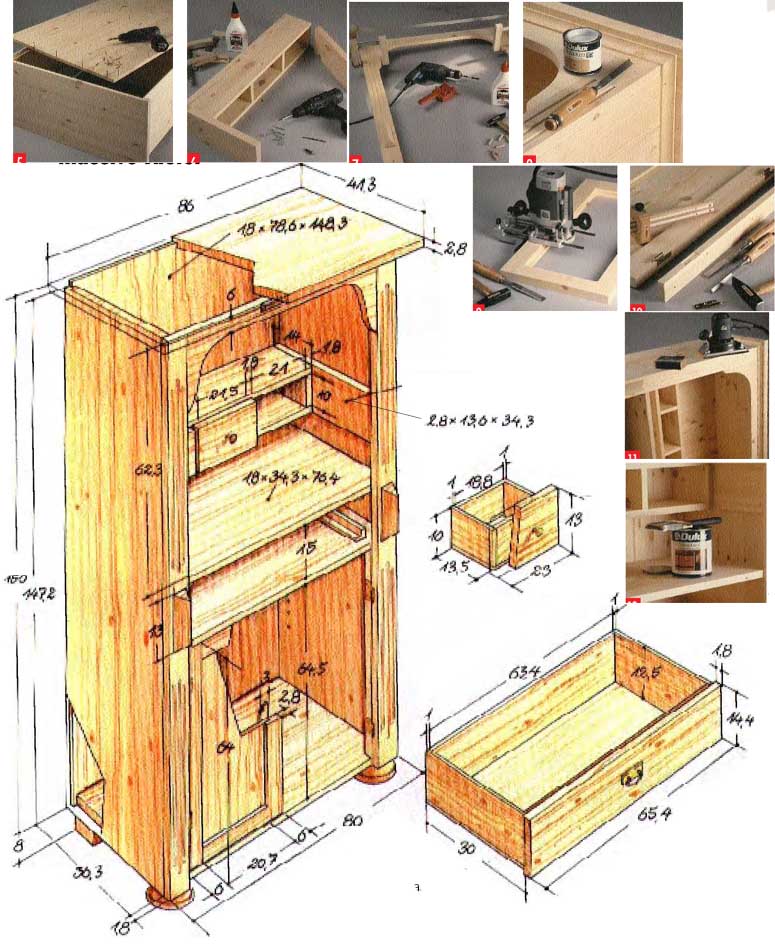 the corpus: Solid pine throughout – Can I make it or can't I make it, recreate the vertical? Who asks this question, because he likes the beautiful country house furniture, he will find an answer by looking at the construction drawing and the working photos on this page. The drawing on the left makes it clear, that the construction principle, after which this vertiko was created, is quite easy: Wooden dowels and glue provide stability for the more heavily loaded connections. The back panel is secured with screws in a rabbet, the drawer insert is also screwed to the body. And all other connections such. B. those of the pilaster strips with the cupboard sides and the coving with the cover are simply glued and pinned. So there are no constructive hurdles with this piece of furniture. But even so, you must have a set of power tools, if the work is to praise the master. Check out the photos, then you are informed about the most important steps. For cutting the individual parts according to the parts list (see blueprint) you need a table saw. The sides as well as the underbody and lid are also rebated with this. You need a drill and a dowel aid, to drill the dowel holes precisely and in the middle. For profiling the pilaster strips or. a router is also required to rabbet the cupboard doors. And you need a jigsaw to saw out the cupboard panel with its curved ends. The orbital sander remains to be mentioned, with which you ensure a smooth surface and round off all wooden edges a little. The hand tools required for construction are standard in every hobby workshop.
the corpus: Solid pine throughout – Can I make it or can't I make it, recreate the vertical? Who asks this question, because he likes the beautiful country house furniture, he will find an answer by looking at the construction drawing and the working photos on this page. The drawing on the left makes it clear, that the construction principle, after which this vertiko was created, is quite easy: Wooden dowels and glue provide stability for the more heavily loaded connections. The back panel is secured with screws in a rabbet, the drawer insert is also screwed to the body. And all other connections such. B. those of the pilaster strips with the cupboard sides and the coving with the cover are simply glued and pinned. So there are no constructive hurdles with this piece of furniture. But even so, you must have a set of power tools, if the work is to praise the master. Check out the photos, then you are informed about the most important steps. For cutting the individual parts according to the parts list (see blueprint) you need a table saw. The sides as well as the underbody and lid are also rebated with this. You need a drill and a dowel aid, to drill the dowel holes precisely and in the middle. For profiling the pilaster strips or. a router is also required to rabbet the cupboard doors. And you need a jigsaw to saw out the cupboard panel with its curved ends. The orbital sander remains to be mentioned, with which you ensure a smooth surface and round off all wooden edges a little. The hand tools required for construction are standard in every hobby workshop.
This sketch makes it clear, how simple this vertiko is. Raincoats or scarves can then be stored behind the doors: Glued wood panels in pine, 18 and 28 mm dick. The only exception: the plywood drawers. The back wall, from two 40 cm wide laminated wood panels glued together, is fitted into the rebate and fastened with Spax screws.
You also have to glue and screw the drawer insert, which is then connected to the body as a whole component.
The panel with the curved ends, cut out with the jigsaw, is connected to both pilaster strips with wooden dowels and glue. A coving, mitred, is donated under the lid, when the pilaster strips and panel are glued to the body.
The frames of the closet doors, glued and dowelled, are rebated on their back. You need a router and a chisel for this.
You will need a chisel and a marking gauge, to embed the brass bands in the frame wood of the doors and in the retaining strips. Fine sanding with an orbital sander and 220 grain follows, if the wood after watering (damp sponge!) is dry again. The wood has a silky sheen and a pronounced grain, when treated with colorless furniture stain. Swipe up to three times!